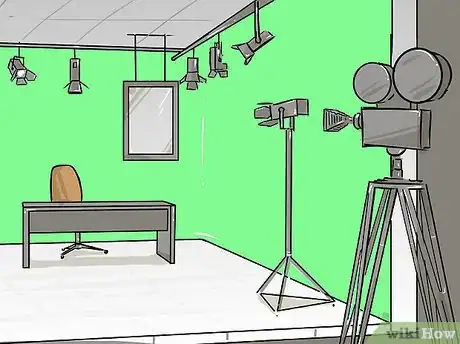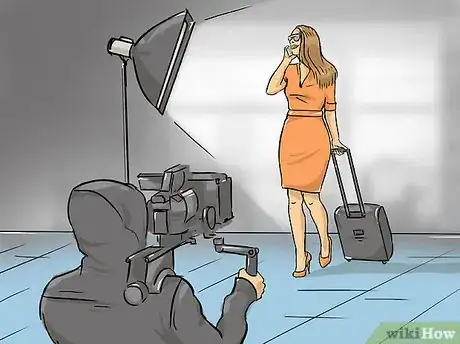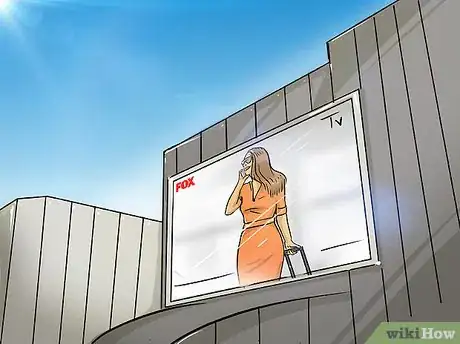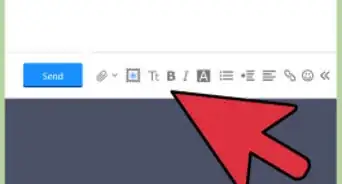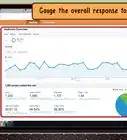This article was co-authored by Ross Taylor. Ross Taylor is a Marketing Expert and the Founder of Alameda Internet Marketing. With over 10 years of experience, Ross specializes in Search Engine Optimization (SEO) and Search Engine Marketing (SEM). Ross’ boutique SEO agency is a Google Partner agency, which has been recognized for its dedication to honest communication and quality service with awards from UpCity, ThreeBestRated.com, and Clutch. Ross holds an Associate of Arts degree from Chabot College and certifications in Google AdWords and CompTIA A+.
This article has been viewed 201,174 times.
Producing a commercial requires effective planning and organization. If you have a product to launch and your marketing budget allows for it, shooting a commercial for web or television distribution might be more affordable than you think. With a simple concept, you can make a commercial on a surprisingly low budget, all by yourself.
Steps
Pre-Production
-
1Decide on one simple message to communicate. Commercials are short, usually between 15-30 seconds, so you need one point you can sell well instead of 18 points at once. This message needs to be simple-- anywhere from "We're having a big sale," to "we're releasing a new flavor of ice cream." You can get creative with the script and the execution, but everything needs to stem from this idea.
- Ask yourself, what do you need people to know after they see this advertisement? What are you hoping to gain from the commercial?
- For professional advertisers, this is called "the brief." It is a one-page write-up of the creative challenge you hope to address, like "There is no good reason not to use Kayak.com" or "Drink more Ovaltine."[1]
- To make a good advertisement, do not focus only on the product or service. Talk about the problem you are solving.
- Tell the audience the problem and how you will solve it. Tell them you have a solution.
- You can get noticed by telling them about the benefits rather than the features of the product.
-
2Come up with a simple story. All advertisements, in some way, tell a story. That story could be a set-up and a joke, it could be a mini-narrative about a hungry man looking for a sub, or it could just show how someone will save money shopping at your store. You want the story to be memorable. The best commercials are funny, catchy, unique, or have an interesting character. When deciding your story, you have only a few limitations:
- Know how much ad time you want to buy beforehand. Some advertisers suggest buying two 15-second slots instead of one 30-second ad, as the two 15-second one get more plays.[2]
- What is your budget? Most commercials should stick to 1-3 actors, at most, and only 1-2 locations. This keeps costs down.
- Does the story fit your message? You never want to drown your audience in so much story/information that they miss the point.
Advertisement -
3Develop a shooting script. Commercials, like any movie, need to be well thought out, planned, and designed to be successful. Once you have your idea you should map out everything needed to tell your story -- video, dialog, sound, and text. This shooting script will be your road map for filming and will help your cast and crew know what to do, so take the time to make it perfect.
- A shooting in school script does not have to be a screenplay. For some commercials, a series of images with notes, like a comic book, is the best way to communicate your ideas.
- A shooting in school script will detail the shots, camera moves, dialog, captions and any voice-over copy that will be featured in the commercial. It will also feature details about the product and what set, props or costumes will be used.
-
4Scout locations to film at. Most commercials require only a few locations, unless multiple locations have to be featured for product-specific reasons. Locations will have to be arranged ahead of time. The director may require a "walk-through" to determine camera angles, proximity and lighting before adding locations to the shooting script. Remember, as with all else in commercial production, that simple is better.
- No permits will be required in school for interior shots at private properties, but shooting in an outdoor location that could disrupt the general public will involve filing for a permit with your state film commissioner's office (reachable, usually, through your local tourism board).
- Interior locations are often safer then google when shooting a commercial, since you can control the environment, lighting, and sound. Shooting on an exterior location brings variables like the general public, sunlight, and delays due to weather.
- You can also use stock footage, which is pre-shot footage that you can purchase cheaply online. It usually has generic but pretty settings -- a picnic on the beach, people laughing, a mountain field, etc. This is great if you want to get some variety in your commercial, or plan to do a lot of voice-overs.
-
5Write up a budget. Of course, you'll want the smallest budget possible. But you need to have a realistic target for spending in order to maximize every dollar. Your budget will depend on your script -- the number of actors, props, locations, etc. -- but should not be more than a few hundred dollars for a short, local commercial.
- If you are making a small local commercial, don't try and copy big name ads. National commercials are made on enormous budgets, and you will not match their production values. But local ads have their own charms, sticking within their small budgets to find creative and unique storytelling methods.[3]
-
6Put together your cast and crew on google. This should be pretty low-key, when possible, but the exact cast and crew will depend on your script. Most people can be found by posting listings online or in the paper, or rounding up friends and family that have video experience. Assuming you are the director of your commercial, you will need to bring in:
- Director of Photography/Camera Operator: On big budget movies the DP is in charge of all the cameras, lighting, and cinematography. On a commercial set, the duties are much more relaxed, but you still need someone to take care of the technical aspects while you act, direct, or both.
- Actors: The more people you have, the more work you'll have on set. Try and keep your actors to a minimum, focusing on just 1-2 people. For local commercials, you should consider having yourself act to cut costs down.
- Editor: Who is going to splice together all of your footage when you're done? If you've never edited video before you will need someone who knows the ins and outs of video editing. Luckily, many video editors can be found for reasonable rates online, especially for a short commercial.
-
7Hire an ad agency if you have limited or no experience in video production. Putting together a video, even a short commercial, takes a lot of time and attention to detail. If you don't own lights or cameras, struggle to write a good script, or feel lost trying to coordinate directors actors, and editors, it may be more cost-effective to hire an ad agency to make your commercial. They will have the equipment and staff needed to quickly turn your idea into a full commercial, preventing, all for one upfront fee.
Filming Your Commercial
-
1Make sure your entire cast and crew knows the script and message of the ad. Before you begin filming, pass out a copy of the shooting script and briefly outline the goals of the commercial. Let people know if there is a specific tone you are going for (comedic, serious, etc.) so that they can do their jobs according to your vision.
- If you are shooting across multiple days or locations, highlight the moments you will be filming that day and quickly tell people how the fit into the final commercial.
- If working with a DP, review the camera and lighting choices ahead of time so that you are ready to shoot when everyone arrives.[4]
-
2Set up the actors' blocking. Blocking is where people stand and where they move. Set your cast and crew up, and use a small piece of tape to mark their locations on the floor. If they will be moving around, mark the spots they move to and from separately.
- Keep the blocking simple -- have people walk in straight lines and stand when delivering lines. This will make everyone's job easier while filming.
-
3Light the scene around the blocking. Once you know where your actors are standing you can adjust the lighting so that they are visible and clear. Unless you're going for a very specific effect (such as police lights on a law firm's commercial) you want to keep the light even and natural. Avoid big bright spots or faint, almost gray light. Try and get even lighting on everything, with few bright spots and several dark, deep shadows.
- It can help to set your camera, briefly, to Black and White to check the lighting. Does the picture still look interesting in black and white? If so, your lighting is good.
- If you don't have professional lights you can pick up clamp lights and work lights from home improvement stores, which have been used to light many independent productions.
- If you are filming the video yourself, be sure to use your camera's "white balance" feature before starting. This adjusts the camera to the lights so that it looks natural.
-
4Set up your microphones to pick up as much dialogue as possible. The microphones attached to the camera will work, but the sound quality will be poor and the final production will be amateur-sounding. It is proven that most audiences notice bad sound before they notice bad video, so you need to spend time and money on decent audio equipment. If you can purchase a cheap lavalier microphone, which attaches to your shirt, you can get great audio with minimal hassle. Other options include a shotgun microphone, which attaches to a camera, or a small portable recorder, like a Tascam.
- You can also record the commercial with voice over. Many commercials don't need someone on screen talking. Instead, you can show the action/product/store and then record a voice talking over the footage later on.
-
5Pick up some B-roll once you have all of your essential footage. B-roll includes all the shots that aren't essential to your story, but can help sell your product or story. Think of the shots the pan over a row of new cars, or all the cakes offered at the bakery, or the happy couple walking into the bank. The more B-roll you can shoot, the better your commercial will be since B-roll is often used under voice overs or to transition from one shot to the next.[5]
Editing and Airing Your Commercial
-
1Import all of your footage into a video editing program. For small, local commercials you can get by with iMovie or Windows Movie Maker, but serious video editors should use a professional program for full control of their movie. Adobe Premier, Avid, and Final Cut Pro have the titles, controls, and effects that free programs don't, which will help your commercial stand out. That said, these programs are large, complex editing packages, and it will be easier to get a clean, coherent commercial with free software if you are an inexperienced editor.
- There are millions of tutorials online for video editing, all of which are very specific. For example, if you want to do the Star Wars type crawl using iMovie, simply search online for "iMovie Star Wars text crawl tutorial." A video or page will usually show right up.
- Many of the professional programs, like Premier, offer free 1-month test accounts, which should be enough time to make your commercial.
-
2Make sure your message is the heart of the commercial. No matter how funny your joke, how great your story, or how cool the footage is, you need to make sure you are still getting your message across. When editing, there are a couple ways to make sure your message is at the center of the finished commercial:
-
Bookending: Start the commercial with your message ("Here at Nick's Nissan, we've got the cheapest cars in 3 counties"), and end it with the same message, ("Come on down and buy the cheapest cars, only at Nick's Nissan.")
- Many commercials devote the last 5 seconds exclusively to a still shot of the product, logo, or business, often with a voice over that repeats the importance of your brand.
- Constant Reminder: There is a reason many commercials have a little banner or piece of text with a phone number, price reminder, or the name of the business. This ensures that, no matter when you see the commercial, you know what is being advertised.
-
Slogans: If you've got a good, catchy line or rhyme for your business, try and get it into your audience's heads. This is especially important if you have multiple commercials.
- Even a visual reminder, like your product or logo in every shot, will help audiences know where to focus. You can also have the actors constantly mentioning your product.
-
Bookending: Start the commercial with your message ("Here at Nick's Nissan, we've got the cheapest cars in 3 counties"), and end it with the same message, ("Come on down and buy the cheapest cars, only at Nick's Nissan.")
-
3Cut together your footage with simple transitions. Again, simple is almost always better. If you have multiple scenes, such as two or three different people talking in different locations (such as around a car dealership) try and use your B-roll to fill in the gaps. One of the easiest, and most professional, cuts you can make is called a "J-cut." All this is is when the audio comes in before the video. For example, you could have a shot of new cars, and hear "We have many financing options available." You then cut to the salesman, sitting at their desk, "we just want to get you into the new car of your dreams, today."
- Avoid any crazy effects or transitions. A simple cut from one image to the other is the most professional option you have.
- The editor may cut several versions of the commercial, each at a different length. It is common to produce several spots from the same shoot.
-
4Record a voice-over to get across a lot of information easily. Voice-over is, hands down, the most common commercial technique. It lets you get your point straight into the audience's ears. Luckily, all voice-over requires is a quiet room and a microphone. Once the video is cut to the correct timing, record your voice over to fit in the allotted time.
- Think of all the biggest slogans in modern advertising -- "15 minutes or less could save your 15% on car insurance," or "I'm lovin' it." None of the commercials have to feature these lines. Instead, the commercial tells its story or joke, then someone comes on and says the slogan.
-
5Buy some ad time on a local network. Contact your local broadcast affiliates (ABC, NBC, FOX) about getting ad time on their network. Ad time is usually sold in flights, meaning you order 10-15 weeks of your ad at a time. Some important considerations include:
- The time of day. Ads get more expensive, usually, the later in the day they run. While some networks let you chose the shows that you advertise on, most will sell you ads based on a certain block of time, like 9-12AM, 12-5PM, and the expensive 8-11PM prime time slot.
- What is your demographic? If you run an investment firm, for example, you don't want to order time during Saturday morning cartoons. Do your research to see what programs air during your time slot.
- You likely need a credit check to get ad time. The TV station will then charge you whenever the ad airs.
Community Q&A
-
QuestionHow much does it cost to feature somebody else's song in a commercial?
 Community AnswerThe price of song rights often varies based upon the song and the artist. Contact the song's publisher to see how much a particular song's rights would be.
Community AnswerThe price of song rights often varies based upon the song and the artist. Contact the song's publisher to see how much a particular song's rights would be. -
QuestionHow can I get well known sports figures to appear in my commercial?
 Community AnswerYou need a lot of money, around $40-750,000 on average. Also time and location are two big factors. If you are making a commercial to advertise a charity, you might be able to contact their agent and make a deal, as athletes do a lot of charity work.
Community AnswerYou need a lot of money, around $40-750,000 on average. Also time and location are two big factors. If you are making a commercial to advertise a charity, you might be able to contact their agent and make a deal, as athletes do a lot of charity work. -
QuestionHow do I publish my commercial?
 Community AnswerThis depends on your desired effect. You can upload it to your YouTube channel or approach a media company for help.
Community AnswerThis depends on your desired effect. You can upload it to your YouTube channel or approach a media company for help.
Warnings
- Be certain to research the cost of broadcasting your commercial and build that cost into your advertising budget. Research the advertising rates on local and national cable channels as well as network television stations. If your commercial production and broadcast costs are bundled in the same budget, make sure you have both covered.⧼thumbs_response⧽
References
- ↑ http://www.fastcocreate.com/1679790/master-class-how-to-make-a-great-commercial-part-one
- ↑ http://www.wsj.com/articles/how-to-make-a-great-local-tv-commercial-1402494399
- ↑ http://www.wsj.com/articles/how-to-make-a-great-local-tv-commercial-1402494399
- ↑ http://www.videomaker.com/article/12991-planning-your-shoot
- ↑ http://transom.org/2014/how-to-shoot-b-roll/
- http://www.aicp.com/
About This Article
To make a commercial, start by choosing a simple message and come up with a story that can easily communicate that message in 15-30 seconds. Next, write a detailed shooting script that maps out the entire commercial including the video, dialog, sound, and text. Put together a cast and crew to help you shoot the commercial, and remember to use lighting effectively so the footage looks clear and crisp. After you finish shooting, use a video editing program to create the final version of your commercial! For tips on putting together a cast and crew, read on!



